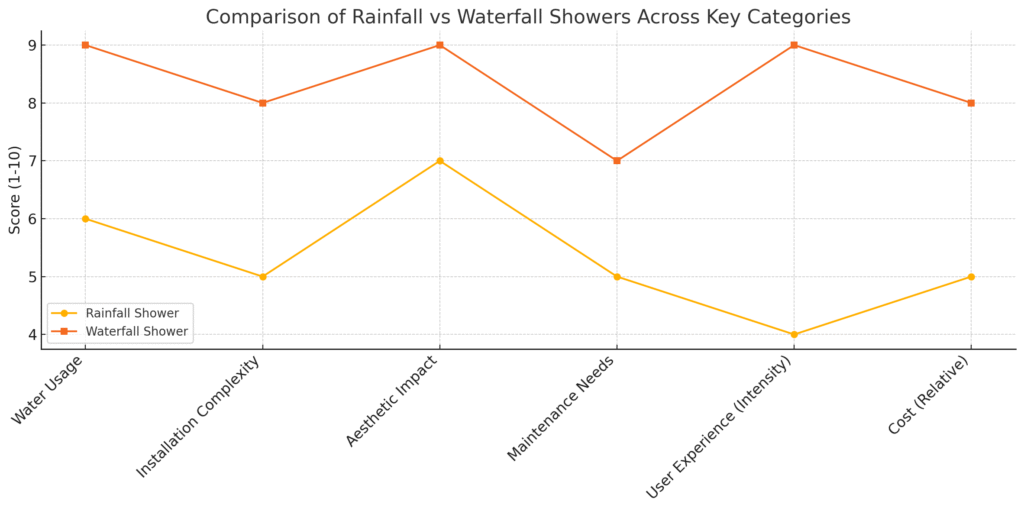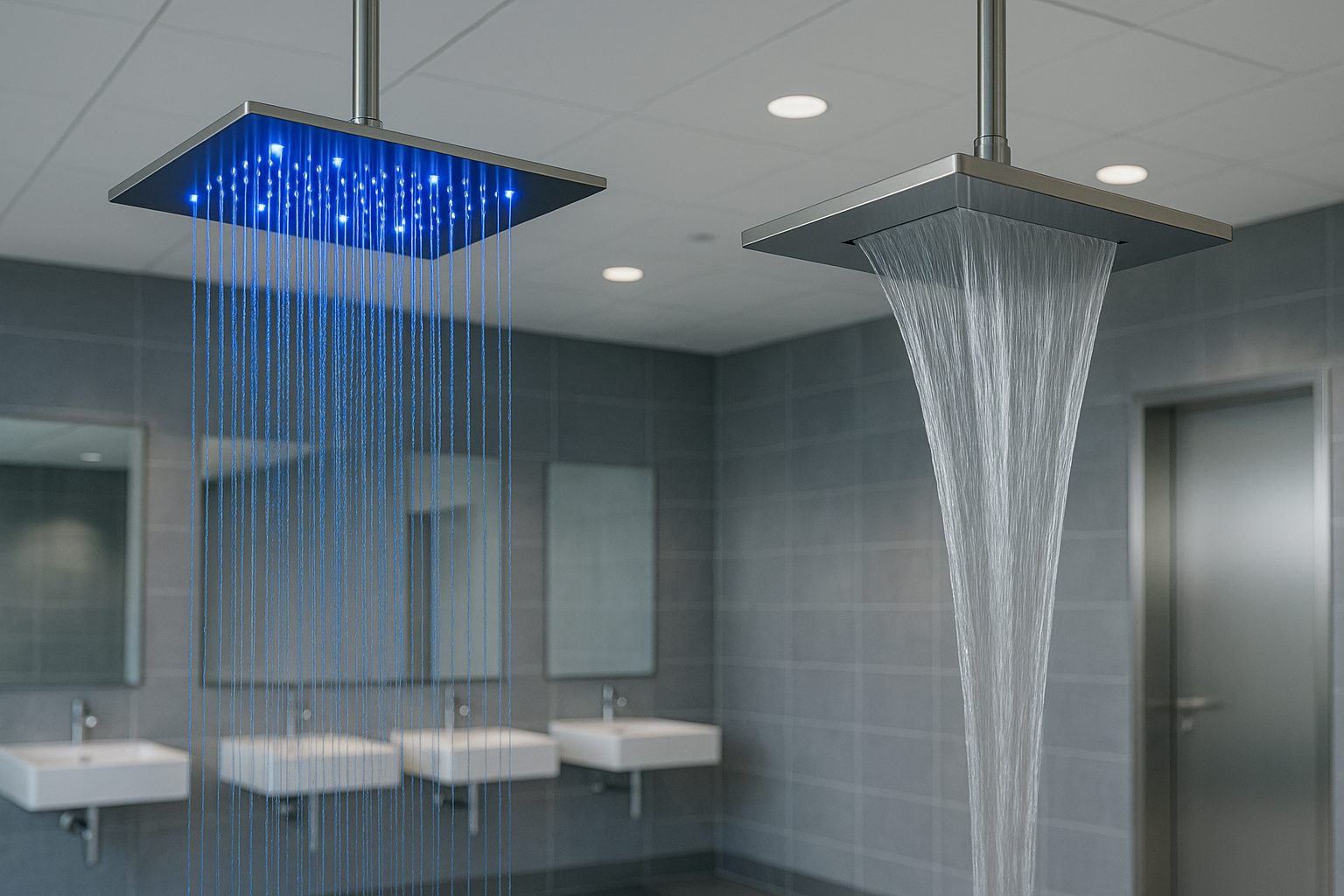In bathroom design today, showers are not mere functional fixtures—they are sensory events. Two of those styles that have ignited the imagination of homeowners and architects alike are rainfall and waterfall showers. Though both aim to elevate the showering experience to higher heights, each does it in a unique way. This comparison guide unpacks their attributes, appearance, installation issues, and user experience to allow you to make the right choice.
🔗 Rainfall vs Waterfall Showers – FontanaShowers
Rainfall Showers
Rainfall showers mimic the sensation of light rain pouring down from above. Installed typically on the ceiling or high on the wall, these systems distribute water all over a wide area with gentle, unbroken flow. Relaxation and coverage, not strength, is the goal.
Waterfall Showers
Waterfall showers, however, are designed to replicate the flow of water off a waterfall. They release a more concentrated, heavier volume of water, usually in the form of a splashy cascade. They can be mounted on a ceiling or wall and are usually built as lavish architectural features in high-end bathrooms or spa-style designs.
🔗 Rain vs Waterfall Showers – Bath Depot
Aesthetic Appeal
Architects and designers both have chances to make a visual statement with either shower design.
Rainfall Showers complement easily with low or contemporary surroundings. Their sleek, often recessed or flush-mounted heads announce a feeling of serene wealth and modernity.
Waterfall Showers are really a work of art. Their bold, forceful water and larger structural components are most ideal for spa-style, tropical, or even industrial design themes. They stand to become the focal point of the bathroom.
🔗 Modern Shower Design Ideas – Kohler
Installation and Plumbing Issues
Rainfall
Rain shower showers generally require plumbing lines at top wall locations or in the ceiling. Although flow rate is usually lower than with conventional showers, water pressure and distribution should be adequate. Large, broad shower heads can also require added support, particularly when installed suspended from a ceiling.
🔗 Rain Shower Installation Tips – Delta Faucet
Architectual considerations
The head requires space in the ceiling for user comfort. Further overhead plumbing can necessitate further waterproofing.
Flow restrictors may be required by local water conservation codes.
Waterfall
Waterfall showers can need more volume of water and higher pressure. Their infrastructure will have to accommodate higher water output and often includes a wider spout or specially engineered trough.
Factors in installation are:
- Supporting structure for heavier fixtures.
- Supported plumbing to handle high water output.
- Drainage design to manage sudden rushes of water.
🔗 High-Flow Shower Design – Grohe
Water Efficiency and Sustainability
Rain shower heads can have the upper hand here. Since rain shower heads spread the water softer and further, they usually use less water than waterfall showers, especially if shower heads with low-flow aerators are installed.
Waterfall showers, as dramatic in design as they are, consume more water a minute due to their higher pressure and volume. For homes where water is limited or where there are sustainability goals, this would be a problem.
For green homeowners and sustainable architects, opting for the rainfall shower with WaterSense certification or other efficiency enhancements is the way to go.
User Experience
Ultimately, the choice tends to be based on what sort of showering experience one desires.
Rainfall showers are a matter of relaxing and calmness. They’re ideal for those who consider showering as a meditation ceremony, or simply for anyone who likes even water dispensing with no harsh pressure. A few users have complained that rainfall showers are not as invigorating or may not rinse shampoo properly due to the soft flow.
Waterfall showers are more dramatic and stimulating. The feeling is often likened to standing under a rushing stream, so it is perfect for relaxing muscles and spa-like indulgence. That being said, the concentrated stream may not be suitable for everyone and may feel overwhelming if not properly installed.
🔗 Choosing the Right Shower Head – Moen
Cost Comparison
Rain shower performances are less costly than waterfalls, particularly if renovating existing bathrooms. Yet custom ceiling mounts or designer rain shower heads have the potential to drive prices higher.
Waterfall showers are more costly based on larger fixtures, greater water consumption, and specific plumbing needs. They are more frequently encountered in upscale remodels or new construction.
Ballpark Costs (including installation):
Rain Shower: $500–$1,500
Waterfall Shower: $1,000–$3,000
Note: Prices vary with location, manufacturer, and complexity of plumbing.
🔗 Shower Remodel Cost Guide – HomeAdvisor
Cleaning and Maintenance
Rainfall showers feature flat, broad shower heads, which tend to need occasional de-scaling, particularly in hard water regions. Their even flat pattern is easier to clean but more frequently.
Waterfall fittings can catch debris using an open trough style and need to be handled carefully so as to not promote mold or mineral buildup in crevices.
🔗 Shower Head Maintenance – The Spruce
Last Judgment: Which One Do You Want?
Choose Rainfall If:
- You want a relaxing, spa-like shower.
- Water conservation is your priority.
- Your bathroom lacks high-ceiling space.
- You’re looking for something contemporary and stylish.
Choose Waterfall If:
- You’re going for a dramatic, sensory showering experience.
- You’re building a luxury bathroom or spa.
- You have a sufficient water pressure and drainage system.
- A centerpiece fixture is in your plans.
🔗 Shower Selection Guide – Hansgrohe

Conclusion
Whether you’re an architect specifying fixtures for a client or a homeowner designing your ultimate bathroom, it’s essential to know the trade-offs of rainfall and waterfall showers. Each provides something unique—rainfall in its tranquility and parsimony, waterfall in its theatricality and sensory overload.
The best one to use is the one that fits within your space, your values, and how you will feel when the water starts.
🔗 Luxury Shower Systems – FontanaShowers
| Category | Rainfall Shower | Waterfall Shower |
|---|---|---|
| Water Flow | Gentle, rain-like | Heavy, cascading |
| Aesthetic | Minimalist, modern | Bold, dramatic |
| Water Usage | Lower (eco-friendly) | Higher (less efficient) |
| Installation | Ceiling or high wall; standard plumbing | Requires strong pressure, good drainage |
| Experience | Soothing and full-body | Intense and invigorating |
| Cost Range | $500–$1,500 | $1,000–$3,000+ |
| Best For | Daily relaxation, small spaces | Luxury spa vibes, statement bathrooms |

No responses yet